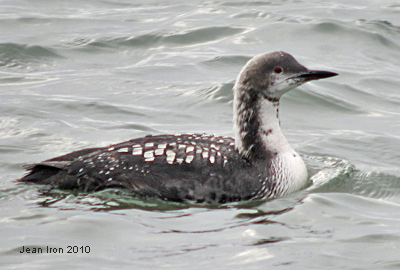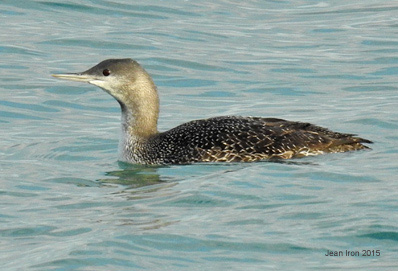| |
|
Loon
ID in Fall and Winter
|
| |
|
by Ron Pittaway
and Michael King |
 |
|
Adult
Pacific Loon molting from breeding to winter plumage on 1 November
2011 at Oshawa. |
| |
|
Revised February 2014. First published in OFO News 16(3):6-7,
October 1998. |
| |
|
Every fall a few confusing small loons are seen whose identity stirs
up debate among birders. Are they Pacific, Red-throated or just
small Common Loons? In this article, we discuss the fine points of
identifying small loons in juvenile and winter plumages. |
| |
|
Ontario Status |
|
The
Common Loon is Ontario's provincial bird. It is a common breeder in
cottage country and northern Ontario and a common migrant on the
Great Lakes.
The Red-throated Loon is a rare breeder along the Hudson Bay coast
in northern Ontario. It is a rare to uncommon migrant in southern
Ontario, but large numbers are sometimes seen.
The
Pacific Loon breeds sparsely in Ontario along the Hudson Bay coast.
It is a prized find in southern Ontario. The American
Ornithologists' Union split the Pacific Loon from the Arctic Loon in
1985. The Arctic Loon of Eurasia is not treated in this article because there
are no records of it close to Ontario.
|
|
 |
|
Figure 1. Common Loon: adult (top left) and small
juvenile (top right) Pacific Loon: adult (middle left)
and two juveniles (head and middle right), Red-throated
Loon: adult (bottom left) and juvenile (bottom right) by
Michael King. |
| |
|
Fall Migration |
|
Adult loons generally migrate before the juveniles, but there is
considerable overlap. The first adult Common Loons return to Lake
Ontario in mid-August, joining the few nonbreeders in various
plumages that have summered there. Adult Common Loon migration
continues through September and October into November. Juveniles
start appearing on Lake Ontario in late September and are common
through October into November. Most Common Loons have left Ontario
by December, but a few may linger into January.
Red-throated Loons, usually singles but sometimes flocks, can occur anytime
but usually later during the
migration period of the Common Loon. Up to 1200
Red-throated Loons have been seen on Lake Ontario in October and
there were over 2000 along the Ottawa River near Ottawa on 12
November 1984. Big Red-throated Loon movements occur one or two days after strong
cold fronts out of Hudson Bay.
The 27 fall records of Pacific Loon accepted to 2012 by the Ontario
Bird Records Committee range from 16 October to 26 December. These
include 11 in juvenile plumage, 19 in winter plumage, 6 molting from
breeding to winter plumage, and two still in breeding plumage. Only
four of the 27 fall records were away from the Great Lakes at Lake
Simcoe, Niagara Falls, Waterloo, and Woodstock. There are also a
small number of spring records of winter plumaged Pacific Loons in
southern Ontario.
|
| |
|
Molt, Plumage and Sex
|
|
When identifying a loon, keep in mind its plumage and molt. There
are three main plumage types to consider: juveniles, molting adults
and winter adults.
|
| |
|
Molts:
Most adult loons are in body molt when seen in fall in southern
Ontario. A few Common Loons acquire almost full winter plumage by
late September, many by mid-October and most by November, but some
are still mostly in breeding plumage in late November. After
migration to the winter range, adult loons molt all their primary
and secondary feathers simultaneously and the birds are flightless
for several weeks. Adult Common and Pacific Loons molt flight
feathers from mid to late winter. Adult Red-throated Loons molt
their flight feathers in late fall, soon after arrival on the
wintering grounds, much earlier than other adult loons. Juvenile
loons retain their full juvenile plumage until January or later
before molting to first winter plumage. |
| |
|
 |
 |
|
Figure 2. Adult Common
Loon in winter plumage with a faintly scaly back. Oshawa on 1
November 2011 |
Figure 3.
Adult Common Loon almost completely molted into winter
plumage but retaining some white spots of breeding
plumage. Oshawa on 1 November 2011 |
| |
|
 |
|
Figure 4. Juvenile
Common Loons have distinctly scaly backs caused by whitish feather edgings. Oshawa on 1 Nov 2011. |
| |
|
 |
 |
|
Figure 5. Adult Pacific
Loon molting from breeding to winter plumage. White squares and
spots will be molted and replaced by plain dark feathers. Oshawa on
29 October 2010. |
Figure 6. Juvenile
Pacific Loon with a distinctly scaly back. Ajax on 1 December 2005. |
| |
|
|
 |
 |
|
Figure 7. Adult
Red-throated Loon shows a gleaming white neck and white in front of
the eye. Niagara-on-the-Lake on 21 December 2005. |
Figure 8. Juvenile
Red-throated Loon shows gray neck and white speckles on the back
forming V marks on the scapulars and wing coverts. Juveniles lack
white in front of the eye. Bluffers Park, Toronto, 24 November 2015. |
| |
|
|
Plumages:
Please refer to the
drawings
and photos.
Juvenile Common and Pacific Loons have distinctly scaly backs
(figure 4 and 6).
Adult winter Commons have faintly scaly backs and adult winter
Pacifics have plain blackish backs, but adults of both species
usually retain scattered
white-spotted breeding scapulars in the autumn
(figures
3 and 5).
Both adult winter and juvenile Red-throated Loons have backs finely
speckled with white
(figures
7 and 8),
whereas other loons have scaly or plain backs.
In juvenile Red-throated, the white speckles on the back differ from
those of winter adults: the juvenile's speckles are grayer (less
pure white), longer and narrower, forming V-marks on the scapulars
and wing coverts. The juvenile Red-throated's
head and neck are washed with a variable amount of gray, sometimes
extensively
(figure
8).
Contrary to some references, Red-throated Loons in juvenile plumage
never have a reddish throat patch. However, some molting juveniles
can have a variable smudge on the throat suggesting the throat patch
of breeding plumage.
Sexes:
Male and female loons are similar in appearance in all plumages with
females averaging slightly smaller. |
| |
|
Swimming Appearance
|
|
Keep in mind that loons (and other diving birds) can markedly alter
their appearance under muscular control by raising or compressing
their plumage. Extremes of the same individual often look like
different birds. For example, loons swim low by sleeking or
compressing their feathers. They also create the forehead bump by
raising these feathers.
Common Loons are heavy set and big headed with a straight robust
bill. They often have a bump on the forehead
figures
2 and 3).
Juveniles and winter adults have mostly pale gray bills
(figures
2 and 4).
Red-throated Loons are small and paler above than other
loons, normally with a sloping head profile (sometimes angular as
illustrated) and pale slender uptilted bill. Usually the small head
and
bill are pointed upwards giving them a snakelike appearance
(figures
7 and 8).
Winter adults have gleaming white necks.
Pacific Loons are slightly larger than Red-throateds, but their
darker coloration, thicker necks and straight bills make them look
more like Common Loons. Pacifics often have a puffy rounded (cobra-like)
head profile
(figures
5 and 6),
but
some show a flat crown
and angular head shape suggesting a Common Loon. |
| |
|
Flight Appearance
|
|
Loons fly swiftly and directly with continuous wing beats. They are
hunchbacked with the head and neck extended and feet held together
sole to sole projecting beyond the tail. Common Loons are heavy with
large feet.
Red-throated Loons are slim with a snakelike neck/head and
small feet.
The difference between a Common Loon and a Red-throated Loon in
flight is like the difference between a Common Merganser and a
Red-breasted Merganser. The flight appearance of a Pacific Loon is
somewhat in between. |
| |
|
Pitfalls |
|
Correctly judging a loon's size, especially a solitary loon at a
distance, is very difficult without a direct comparison with another
bird or object of known size. As well, a few small Common Loons of
all ages occur widely throughout its range. However most
identification problems arise with those juvenile Common Loons that
are small in size with short bills. Caution: Red-throated Loons are
sometimes misidentified as Pacifics, particularly juveniles which
sometimes don't show the classic upturned head/bill appearance such
as in Figure 1 (bottom right) and Figure 8. |
| |
| |
|
|